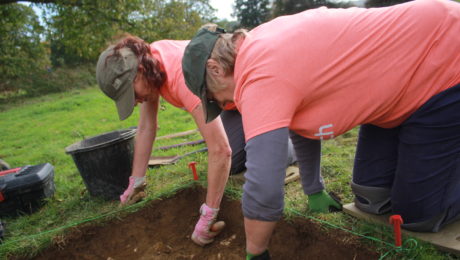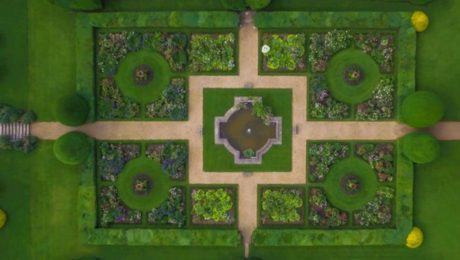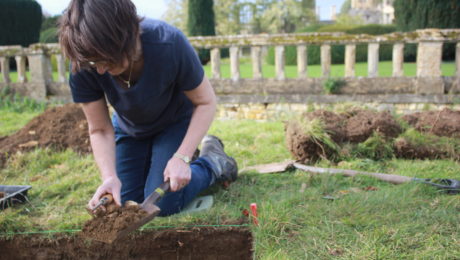When the grand pages of history are dominated by castles, manor houses, and fortifications, it’s easy to think of gardens as little more than decorative doodles. But just as deer parks were used to cement social and political relationships in the early 16th century, Tudor gardens – and the royal tents often built within them – became places to entertain, feast, and to display newly found wealth, success and power.
One particularly detailed description of a temporary banqueting house built at Whitehall in 1581, ahead of negotiations for Elizabeth’s potential marriage to the Duc d’Alencon, states that the 332 foot long structure took 3 weeks and 3 days to build, was held up with 30 masts, and involved 375 people. The canvas walls were painted to look like stone, the roof was painted with stars, clouds and sunbeams to look like the sky, while the insides decorated with “292 glass lights… and… all manner of strang[e] flowers… garnished with spangs of gould [and fruits like] pomegarnetts, orrnges, pompions, cowcumbers, grapes, carettes, peas and such like”.
As historians are increasingly beginning to assert, these royal tents were not only enormous and elaborate undertakings that often took weeks to build, they are also vital to a proper understanding of Tudor politics, in which a mobile court that could indulge in elaborate displays of wealth and magnificence while moving around country was fundamental.
And as we approach the 500th anniversary of the Field of the Cloth of Gold (the meeting that took place just outside of Calais between Henry VIII and Francis I, King of France, and which took its name from the array of fabulous golden tents that housed the two kings’ entourages), the potential significance of this discovery becomes all the more clear.
This was especially true during the reign of Elizabeth I, whose love of display accelerated the creation of increasingly elaborate gardens. Unlike her father, for whom it was unthinkable that any noble might live in more splendid surroundings than his own, Elizabeth egged them on, and indoor politicking spilled into the open.
Each summer, Elizabeth and her court would leave London on a ‘progress’ around the country, lodging with noble families often for weeks at a time. These visits were highly coveted by her two closest advisors; Dudley, a close confidant harboring romantic intentions, and Cecil her chief political advisor intent on keeping Dudley at bay. To entice Elizabeth to visit, and amuse her once she arrived, they created gardens and landscapes of increasing complexity, each bolder and more elaborate than the next.
Rosemary bushes shimmered with gold leaf. Bridges magically brimmed with wine. Dudley and Cecil, the two most powerful men in England, driven by their rivalry, devised ever more elaborate gardens to impress their queen.
It’s little wonder, then, that as Elizabeth toured the country, each of her hosts felt compelled to construct brand new gardens ahead of her arrival – each one a miniature wonderland, where the queen and her retinue would revel, feast and be entertained.
But these visits served a dual purpose. The “honour” of such a visit could also reduce a lord’s wealth substantially; Elizabeth and her retinue would devour all their stores. By the time they finally left Sudeley Castle in 1592, her host Lord Chandos had nearly bankrupted himself.
The startling thing is that for all their extravagance, barely a single Elizabethan garden survives. If they weren’t destroyed in the Civil War, they crumbled into ruin over the next few decades. And those that made it any further were erased during the popular landscaping movement of the 18th and 19th centuries.
Most of our ideas about Tudor gardens are based on a handful of illustrations and descriptions. Where they do actually survive, in most cases it’s only the earthworks that survived – the viewing mounds, and the terracing, the pavilions, but the beds themselves don’t usually survive because they’re more ephemeral.
The ghostly outline revealed at Sudeley Castle gives us a unique chance to unearth an original Tudor garden, and recover a moment in time when the humble garden became a beloved part of English life, and took on an even more important role: one of political influence.





